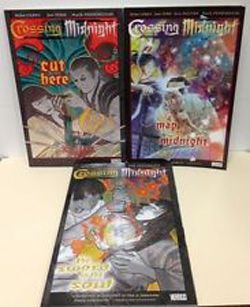 It’s a little strange for someone who’s become addicted to Japanese comics, which generally use character designs that partake of no particular ethnicity (aside from the occasional parody of Utamaro), to read a comic in which the characters are identifiably Japanese.
It’s a little strange for someone who’s become addicted to Japanese comics, which generally use character designs that partake of no particular ethnicity (aside from the occasional parody of Utamaro), to read a comic in which the characters are identifiably Japanese.
In the case of Crossing Midnight, there’s good reason for that: the story takes place in Nagasaki and Tokyo, and the main characters are a brother and sister who’ve gotten entangled with some rather difficult kami (spirits, we’d call them). It all starts with an offering made at the Hara family shrine at Grandmother Akiko’s insistence, a prayer for the safe delivery of her son’s first child — which turns out to be two children, Kaikou, born one minute before midnight, and his sister Toshi, born seven minutes after. It turns out that the kami of the shrine, Akatsu, took it as a bargain, and the offering that was made he considers insufficient: he appears when the twins are in high school, demanding his payment — Toshi. Akatsu, as it happens, is the kami of knives and swords — anything, in fact, with an edge or a point — which explains why Toshi can’t be cut or stabbed: he has claimed her, so she is immune to injury from those objects he rules. Ultimately, Toshi agrees, somewhat under duress — her family is in danger — and follows Akatsu into his world. Kai, however, is determined to bring her back. And it seems that Akatsu is a usurper, and those who were loyal to the original kami of knives, Asirosamiro, aren’t resigned to his rule. When Kai goes in search of Toshi, he finds allies.
An acquaintance called Crossing Midnight a “horror story,” and I suppose in some respects it is. There are certainly enough beheadings and dismemberments to satisfy even fans of slasher flicks. It goes somewhat beyond that, though: Carey has made use of aspects of Japanese folklore, in the kami and youkai who inhabit the story, and contemporary Japanese popular culture in the story arc in A Map of Midnight — the terekura (telephone clubs) and the teenage girls who use them to find what we could call “johns.” (Carey devotes an afterword in his volume to the phenomenon of enjokosai (“compensated dating”) that’s worth reading, if only to point up the differences in attitudes in Japan and America.)
The story is rich and engaging — there is all sorts of history here, as well as changing rules of engagement hinging on differing interpretations of what the bargain was (there’s always a bargain) and outright betrayals, all of which ring true in the context of the Japanese kami and youkai. (What we would call spirits, fairies, elves, what have you — anything and everything in this instance except, perhaps, gods, although Japanese usage is rather fluid on that score, and some of these creatures could, in fact, be considered gods.) While the first two volumes, Cut Here and A Map of Midnight, seem almost fragmented, there is a strong thread of continuity that in the third volume, The Sword in the Soul, comes to a tragic climax of Shakespearean cast — I almost want to say “Euripidean,” because there is that kind of inevitability to it, but only in retrospect — the reader is pretty much blind-sided by the tragedy (at least, this reader was). The ending really reminded me of the end of King Lear more than anything else.
The art fits like a glove. It’s penciled mainly by Jim Fern, with assists from others as the story progresses, in a nice, open, clean comic realism style that gives a nice, solid feel to the graphics while ensuring legibility throughout — even in the heavy action sequences. The graphic treatment of the kami is especially choice — everything from late Edo Period samurai to contemporary goth, with enough grotesques to make it seem truly Japanese.
And no, it’s not Mike Carey trying to do supernatural manga — his afterwords in the first two volumes do a lot to explain not only the basis in Japanese culture for his borrowings, but the ways he has altered the originals.
(Vertigo, 2007/2008)
